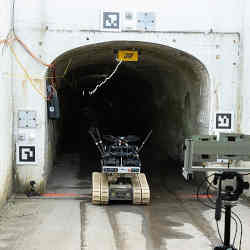
In the aftermath of a major flood, mudslide, earthquake, mine collapse, shipwreck or structural failure, first responders must move quickly—but also must tread carefully. In many cases, it is difficult to spot survivors in rubble and debris, and working conditions can range from challenging to extraordinarily dangerous.
Although there is no simple fix, robotic devices and sensing systems are beginning to fly, creep, crawl, and otherwise locomote into the physical world. Using advanced sound detection systems, cameras, infrared, biosensors, and other equipment, researchers are engineering robotic devices that can aid first responders and take search and rescue into the digital age.
Says Timothy Chung, program manager in the Tactical Technology Office at the U.S. Defense Advanced Research Projects Agency (DARPA), "Robots can provide insights that save lives and deliver other critical information across a spectrum of emergency situations—including places where lighting and breathing are challenges."
A Sense of Safety
Today's search and rescue techniques typically involve holding flashlights and listening for sounds from victims of a disaster. Robotic rescue technology will arm responders with electronic eyes, ears, and even noses, so they can better explore difficult-to-reach places. "The ability to use autonomous and highly mobile systems that can sense the environment and communicate in real time changes everything," Chung says.
The field is advancing rapidly. At Germany's Fraunhofer FKIE ICT research institute, for example, a multidisciplinary team has equipped a drone with a small unit that's able to "hear" human shouts and other sounds emanating from a person in distress and identify their location. The listening device, weighing in at about two pounds, relies on a cluster of inexpensive MEMs microphones and other components to capture and process sounds, which are fed into an algorithm.
The system has proved highly accurate. It typically can locate a person shouting or making other sounds to with half a degree of its field of vision. Using signal processing techniques and artificial intelligence (AI), the group has found ways to mask environmental noise produced by the rotor, vehicles, and animals, and to pinpoint critical sounds such as shouting, clapping, and banging on objects. "The technology can cover a large area quickly and send location information about survivors to rescuers," says Macarena Varela, a researcher at Fraunhofer FKIE.
At Carnegie Mellon University, a research group headed by Howie Choset, a professor of robotics, biomedical engineering, and computer engineering, has developed a collection of modular snake-like devices that can slither through debris while attached to a tether that can extend several hundred feet. One such remote-controlled snake, about four feet long, uses cameras to see into hidden places; it was used to search for survivors after the Mexico City earthquake in 2017.
Meanwhile, at the University of Washington, researchers have developed a biohybrid system that relies on insect antennae and silicon systems to detect biomarkers in the surrounding atmosphere. The robot is the first flying biohybrid system to successfully perform such odor localization in a confined space—and it outperforms silicon-only systems. "It's able to pick up biomarkers while detecting and avoiding obstacles in its flight path," says Tomas Daniel, a biology professor at the university. "We are seeing the emergence of technologies that integrate with natural systems and use AI to detect living things."
Rescue Robot
DARPA is pushing research further. Its Subterranean (SubT) Challenge, which involves having drones map, navigate, and search a variety of underground environments during time-sensitive combat operations or disaster response scenarios, attracted 24 teams from around the world. Each developed wildly varying robotic sensing systems designed for tunnels, caves, and urban underground environments. The SubT Challenge, which includes $5 million in prizes, is running its final event on September 21-24.
"The value of these robotic systems is that they help first responders understand where to go and what equipment to bring in situations where every minute is precious and lives are in the balance," DARPA's Chung says. "These rescues are often very difficult and dangerous because of all the unknowns and difficult environmental conditions." He says that the goal is to develop a system that uses multiple sensors and highly adaptable communications technologies to improve its detection and notification capabilities.
Advanced rescue technologies could deliver other benefits, Thomas notes, including the ability to sniff out or sense hazardous gas leaks, incipient fires, explosives, and toxic chemicals. He says the three factors critical for producing fully functional systems are: ultrafast response in a package that balances size, weight, and flight factors; the ability for such devices to operate truly autonomously in real-world conditions, and sensing abilities that avoid false positives and false negatives.
Developing systems that can canvas radically different physical environments is key, Choset says. In some cases, this may necessitate multiple connected robots and other devices—along with better batteries. "It's an incredibly difficult challenge because the software has to coordinate an incredible amount of data, including internal degrees of freedom in three-dimensional spaces as well as complex sensory information," he explains.
Yet make no mistake, robots are coming to the rescue soon. Says Varela, "In the commercial realm, it's still early with these technologies. But they are likely to make an impact within the next few years. They will save lives."
Samuel Greengard is an author and journalist based in West Linn, OR, USA.



Join the Discussion (0)
Become a Member or Sign In to Post a Comment